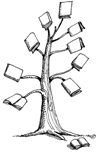Book Selection
 General Principles
General Principles
Scaffolding Literacy has identified
the following criteria for choosing narrative text. (Schools and Community
Centre, Scaffolding Transitional Spellers, 1998. page 6)
1. Issues relating to the
staging of the text
The structure of the story
The complexity and coherence of the event sequence
2. Language choices in the
text
Image building and precision elements
Expression of characters' thoughts, feelings and reactions
The length of sentences
Variety in sentence structure
3. Visual elements and presentation
Illustrations, size of print, layout
1. We look at how obvious is the orientation, complication and resolution.
The Wishing Well in Arnold Lobel's Mouse Tales is a perfect example
of story structure for very young children. The Witches or Matilda by
Roald Dahl have less easily grasped resolutions - the reader has had
to pay attention to the author's comments at the beginning of these
novels to be prepared to accept the endings. Judging only from plot
structure, the latter books are obviously for older children. We can
teach plot design appropriate to the first years of school from The
Wishing Well. We can teach plot design appropriate to late primary school
from The Witches or Matilda.
Early examples of coherence
in the event sequence are provided by Lobel's Frog and Toad stories,
where the difference between the two creatures' reactions provides the
basis for the action; and by The lion and the mouse, (Connections) where
the small creature does things appropriate to small creatures and the
big creature does things appropriate to large creatures. We see how
this has developed in a novel for older children like Bartlett and the
ice voyage by Odo Hirsch, where the development of the action depends
on how well Hirsch has drawn his characters. In Frog and Toad, this
is through action-reaction. In Bartlett, this is through description,
through knowing the characters' thoughts and through seeing the characters'
actions and reactions in a variety of scenes.
2. We have talked a lot about language choices over the past two weeks.
When we have talked about 'exact' words or 'precise' words we are meaning
precision elements. These words can be verbs, nouns, adjectives or adverbs
that are precisely chosen. Even in a simple story like The Wishing Well
Lobel has written 'cried' instead of 'said' when the little mouse is
excited. Without any such precise words, a book is not worth studying.
In Bartlett, when they hit the iceberg, Hirsch has included similes,
metaphors, and personification, and sustained a metaphor likening the
icebergs to savage beasts over several pages.
As we saw in The 27th annual
African hippopotamus race, long sentences can be harder to read than
short ones, and will need careful teaching if children are to use them
in their writing. In the texts we study we look at different ways of
combining clauses and phrases. Long sentences appear in books for young
children - we looked at 'Coming from the other direction was fox, slinking
along with a string of fish that he had stolen' from Why the bear has
a stumpy tail - and they need to be explained.
When we began choosing texts,
we looked at whether authors tell, and how they tell
who
what
when
where
why
how
By looking at how they tell
these things, some of the language choices we have learnt to look for
are:-
Whether the text is complete in itself. This can be explained by comparison
with children's oral 'news' where they don't realise the need for giving
the context. Once this need is realised, children are moving into literate
language. In a story for very young children like The Wishing Well (the
first story in Lobel's Mouse Tales) the context is created largely by
the pictures and children need to be shown how to interpret pictures.
But as well, the first sentence reads 'A mouse once found a wishing
well', where the word 'once' puts the story into the context of long
ago stories.
How action sequences are written.
Whether reactions help move the action along. Including reactions as
well as actions greatly improves children's writing
Whether sensing verbs, thinking
verbs are included. - Robin Klein is an example of an author who lets
us know what the characters are thinking - including thoughts greatly
improves children's writing.
Whether statements are expanded
- Paul Jennings writing contains good examples of this. This is another
choice that can greatly improve children's writing.
Precise words.
Image building words
Appropriate description
Whether the author comments
on the action, and how appropriate are the comments.
How clauses are combined into
longer sentences. How phrases are added.
Beginnings and endings of sentences.
3. Check that the print is readable, the format is appealing, and what
function the pictures have in relation to the text.